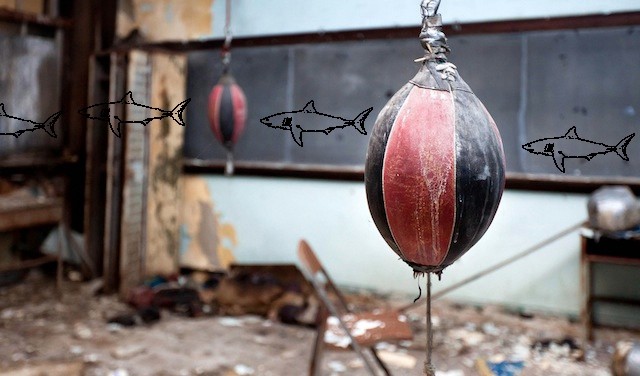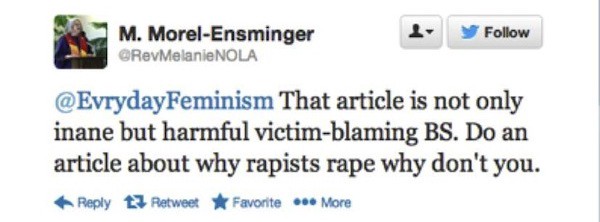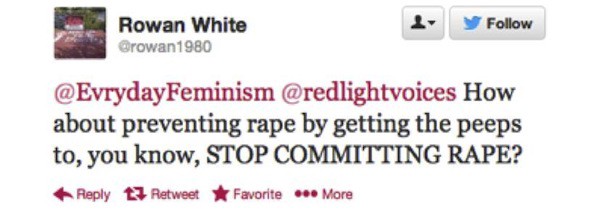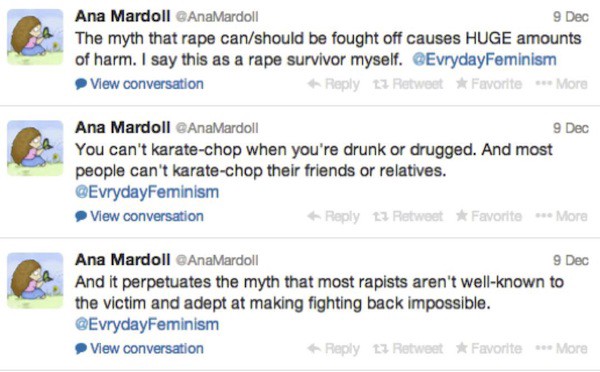The Shark Has Pretty Teeth, Dear: Why I Teach Women Self-Defense
by Susan Schorn

I took my first empowerment-model self-defense class in 1999, and I’ve been teaching it since 2000. For 14 years, I’ve been deeply invested in this way of helping women, children, and other targeted populations discover their power and reduce their risk of harm.
Empowerment self-defense, or ESD, was developed by feminist activists who rejected the old, male-designed-and-taught self-defense models of the ’50s and ’60s. They wanted a system that taught practical skills within the context of rape culture; one that addressed the physical, mental, emotional, spiritual, and social/cultural components of self-defense. The ESD model is constantly fine-tuned by the people who teach it; today, for example, the National Women’s Martial Arts Federation curriculum for ESD requires instruction on the culture of violence, boundary setting, and physical skills (including awareness and escape). Built on an ethical framework developed by the National Coalition Against Sexual Assault, it states that “accountability for violence lies with the person who commits it and that everyone has the right to make choices about whether or not to fight back,” and that “good self-defense programs do not ‘tell’ an individual what she ‘should’ or ‘should not’ do,” but offer “options, techniques, and a way of analyzing situations.”
I learned ESD from the women who created it, and I teach it alongside those who have adapted and shaped it in response to the latest research about violence and trauma. For 15 years, I’ve lived by the ethics encoded in ESD — not only when I teach, but in my day-to-day life as well. Doing so made me stronger, more confident, more engaged in the fight to end violence. It reduced my fear and anxiety. It helped me make peace with my vulnerability.
So I was surprised to learn last month that my embrace of empowerment self-defense marked me as not only a shitty feminist, but a perpetuator of rape culture.

Lynne Marie Wanamaker, a nationally recognized expert with two decades’ experience teaching empowerment self-defense (and co-author of the NWMAF Core Competencies for ESD instructors), has identified something she calls the “self-defense paradox”:
One facet of this paradox is the fact that a single person — the perpetrator — holds sole responsibility for the decision to assault someone. The other is the fact that people at risk of violence can take effective steps to increase their own safety.
These facts seem contradictory, yet both are true:
- No one but the attacker bears responsibility for an attack.
- The attacker does not hold all the power. The person targeted has power, too.
If we become trapped in this paradox — if we insist on rejecting one half of it or the other — then we cannot make progress toward a safer world.

When I think of rape culture, I picture the teeth in a shark’s mouth: Sharp, serrated, and cruel; a vast array of lethality. Each lewd joke told at the expense of my gender, each discriminatory healthcare policy, each untested rape kit, is a separate keen-edged weapon in rape culture’s hunting and consumption of women.
The tools of rape culture, like a shark’s teeth, are highly evolved implements, honed for maximum efficiency in their work. They are numberless and endlessly replenished. Dislodge one from the ranks of like instruments and a new one grows to take its place: a new voter restriction or anti-abortion law, a new sexist internet meme, a new flurry of hatred against a female celebrity.
Another feature of sharks’ teeth is that they are raked backwards, their points slanting down into the depths of the animal’s throat. This arrangement makes prey easier to hold, guiding it relentlessly downward, gulletward — toward digestion.
The paradox of self-defense can paralyze us with doubt or lock us into conflict with people who share our goals but not our particular understanding of the problem. And in that instant, when our movement is frozen: Gulp.

Last month, the website Everyday Feminism published an article by Danica Johnson titled “Ways to Protect Yourself from a Possible Sexual Assault.” (The piece is no longer available online). Among the author’s bold claims and strident demands: “Education and Action Can Equal Prevention in Some Cases”; “Educate Yourself about Date Rape and Intimate Partner Rape”; “Learn the Power of Your Own Voice” and “Take a Self-Defense Class and Learn How to Fight Back.” The article also took pains to repudiate victim-blaming: “Rape — whether perpetrated by the young or old, by a man or woman, towards a man or towards a woman — is never, under any circumstance, the fault of the victim” (original emphasis).
Johnson’s piece was far from flawless. Some of the information it cites could be better sourced. The article makes a few recommendations that sound impractical at best — it touts a newly-invented drinking glass, for example, that changes color when exposed to date-rape drugs. Its tone drifts from helpful enthusiasm to something more like scolding. In fact it did many of the things that Everyday Feminism had cautioned against just a few weeks earlier, in an excellent article by ESD instructor Lauren Taylor.
Still, the majority of the information Johnson provided was practical and evidence-based. Yet online reaction was swift and harsh.



This was only the beginning of an onslaught of arguments arising from the paradox of self-defense: a logical Möbius strip that labels any discussion of women’s ability to thwart rape “victim-blaming.”
Some commenters felt that, instead of an article about reducing the risk of rape, Everyday Feminism should have published one about the psychology of rapists:



I love the idea of tasking men with the dismantling of rape culture. I’ve even read about the concept online, in fact. However, making that the only acceptable strategy for dealing with rape culture seems naive and, frankly, dangerous. It requires a faith in male chivalry that I’m afraid I don’t share, not to mention a firm belief in men’s competence at solving large-scale social problems. Don’t get me wrong: I’m sure men can end rape culture eventually — maybe even before they abolish the military-industrial complex — but aren’t we allowed to have a back-up plan in the meantime? Can’t we, in other words, do both? Teach men not to rape, and teach women to fight back against rape?
One survivor of assault I know pointed out, “It takes all of 30 seconds to give a woman a self-defense tip. How long does it take to evangelize the world about violence against women?” The research backs her up. The National Resource Center on Domestic Violence has a sobering comparison of the efficacy of men’s rape prevention programs versus women’s. There’s no contest: Women’s prevention programs, particularly those involving physical self-defense, reduce the risk of sexual assault. We know that. Men’s programs? We don’t even have a good way of measuring their effect yet.
Other critics on Twitter attacked Johnson’s article by dismissing practical self-defense instruction altogether. These voices variously derided Everyday Feminism for advocating “karate-chopping” classes, insisted that women cannot physically resist male rapists, or claimed that the possibility of armed attack negates any potential benefits of self-defense training:


One Twitter user called self-defense “illogical” because even if one woman fights off an attacker, he can just find a weaker woman to target:



Clearly, some of these respondents may be dealing with significant trauma of their own. Indeed, the fact that victims of assault may be traumatized merely by reading about preventive measures is a symptom of their trauma. The responsible and compassionate way to respond is to provide resources for their healing.
Not coincidentally, ESD experts have done exactly that. Many of the activities students engage in during an empowerment self-defense class are almost identical to somatic therapies recommended for trauma survivors. Wanamaker, herself a survivor, attests to the value of ESD training in her own healing: “The practice of being present in my body,” she says, “experiencing the neurobiological trauma-based fear response that is the after-effect of violence (call it PTSD, triggering, whatever), and being able to self-calm in the context of not being re-violated — in fact, in the context of having my boundaries affirmed and respected more radically than anywhere else in my life — is what enabled me to recover from trauma.”
You know what is not a reasonable or compassionate response to survivors’ trauma-based reactions to self-defense advice? Declaring all discussion off-limits. Joanne Factor, another veteran ESD instructor, says it this way:
It is critical that survivors be heard and acknowledged; they are speaking from their own experiences. It’s also critical to point out that they do not speak for all survivors. While they themselves may feel they would not benefit from self-defense as a healing path, there are many women and men who have — and who also should have their voices heard and respected.

When our conversation is allowed to include practical, proven information, things look less problematic. This brief summary of research on self-defense efficacy, compiled by Katy Mattingly, MSW, an empowerment self-defense instructor at the University of Michigan-Ann Arbor, provides several good examples. Over and over again, formal studies show that “forceful verbal and physical resistance and fleeing [three of the most common strategies taught in ESD] have a proven association with rape avoidance in both reported and unreported crimes.”
Wanamaker likewise rejects the argument that self-defense doesn’t work. That argument “denies the reality that women fight back all the time. Women don’t need upstart feminists to tell them to fight back against rape. Untrained women fight back, and are frequently successful in fighting back.” Arguments against teaching self-defense, she says, imply that “the instinct to self protection is something self-defense instructors impose on helpless women, who otherwise wouldn’t have any impulse to defend themselves.”
I’d argue that most claims that “self-defense doesn’t work” assume that women are biologically weak, and instinctively passive. You may call that feminism, but to me it feels like a shark’s tooth.

Some Twitter users focused on the article’s advice about using one’s voice, implying that this was a silly or (even worse) not-properly-feminist approach:


How is yelling and eye-gouging feminism? Speaking as a feminist who has practiced and taught eye-gouging, and who has been stabbed in the eye with a metal-hafted practice knife, I feel well-qualified to speak to this question. Gouging someone’s eye is the most devastating way to disrupt an attack, and by far the easiest. Tell me, have you ever grabbed your own face with both hands to check if your eyeball is dangling outside its socket? I have. Feminism doesn’t get any more radical than that.
I also feel qualified to defend “yelling” as feminism. Our voices are one way we can define ourselves. They let us set boundaries. They project our power. They connect us with others who can help us escape harm, or heal from it. Communication skills are critical to transformation of all kinds: personal, interpersonal, political. The ESD instructors at Thousand Waves Martial Arts in Chicago teach an entire workshop devoted exclusively to communication skills. When I teach, I spend at least a quarter of every class on the concept of “Yell” — that’s how vital it is to empowerment and safety. Yelling is the opposite of silencing. Yelling stands at the very heart of feminism.
That’s a concept that, frankly, someone who is clacking away on Twitter, claiming to represent the true voice of feminism, really ought to think twice about before dismissing.

Someone at Everyday Feminism — whoever was handling their Twitter feed that fateful December morning — made a few fitful attempts to defend Johnson’s article, but paradox is a tough thing to explore in 140 characters. Especially when people smell blood in the water:


If…
- discussing women’s ability to defend themselves is, ipso facto, victim-blaming;
- sharing information about reducing the risk of violence is anti-feminist;
- “saying women have the power to avoid being raped” is forbidden;
then we cannot have a productive discussion about staying safe. We cannot take practical steps to improve women’s safety, no matter how much evidence we have that those steps work. We can only — and I find this odd, given that we are ostensibly fighting over women’s well-being — talk about men, and what they need to do.
Distorting the debate in this way doesn’t just affect the online chatter of American feminists. It affects the safety and health of women everywhere. Lee Sinclair, founder and program director of No Means No Worldwide, works tirelessly to bring empowerment training to girls in places like Nairobi, where one in four high school girls is raped each year. Recently, while speaking to several major international funding organizations, Sinclair was told, “The belief is that fighting back will only make the attacker more violent, that he’ll hurt her worse.” And there is “concern that if girls don’t take your classes and then they are raped that the blame is on them.”
When Sinclair offered evidence to counter these “beliefs,” the funders claimed they didn’t believe such things; of course not: “That’s just what’s being said out there.”
“What’s being said out there” is demonstrably wrong, and yet it’s choking off funding for programs that are reducing harm right now, for women at very high risk of violence. Remember, the shark’s teeth slant backwards: Patriarchal and male-dominated institutions are already less inclined to put money toward helping girls. These rumors and myths about women’s empowerment — the same ones being promulgated by self-proclaimed feminists on Twitter — provide a convenient excuse to re-direct funding. “We must teach boys not to rape,” after all. Where will we find the money to do that? Why, we’ll take it away from programs that serve girls. Programs like this one.
Gulp.

If we could defer our anxious need to resolve the self-defense paradox, we could have a conversation. We might share our understanding of responsibility and power, and examine where those concepts overlap. If we could live with a little cognitive discomfort for a while, we could all try to learn from each other. That would be an enlightened and brave and — to my mind — feminist thing to do. But it didn’t happen in this case, because Everyday Feminism, clearly stunned by the brutal response to its humdrum article, opted to resolve the paradox with an abject apology, for daring to advocate self-defense.
In a stand-alone page (which has also now been removed from its website), the “Everyday Feminism Team” expressed their desire to “to publicly and formally apologize” for Johnson’s article (Johnson was not identified by name in the apology).
“We want to be clear that we hear you,” the “team” assured the voices of outrage, “and that you’re right.” [Bold and italics are original.] Johnson’s article “was insensitive and ill-conceived, as it promoted many of the same victim-blaming arguments that we work so hard to dismantle.” They thanked readers for “speaking up about and calling out our harmful behavior,” and expressed appreciation for “being held accountable for an egregious error.” The mea culpa closed with an ambitious statement of feminist purity: “it’s important for the movement, in solidarity, to promote the right messages. We apologize for not being a part of that unified voice today.”

I asked some of my fellow self-defense instructors what they thought of this message. Many of their comments (especially from the over-60 set, the women who’ve been working on violence prevention for 40 years and more) were unprintable — and no wonder. These are teachers who have dedicated their lives to reducing violence and empowering women, and Everyday Feminism had just labeled them rape apologists and cast them out of the approved circle of feminist thought.
“Bizarre, cowardly and ill-informed,” was one of the tamer responses. “They’re making it impossible for any discussion to take place,” another pointed out. “How will a unified voice emerge?” “The patriarchy will not be overturned by people who just firmly know how right they are,” my friend Denise observed.
Mattingly professed to being “particularly confused by this line in the public apology: ‘People who have internalized society’s messages about not being good enough and deserving to be oppressed, violated, exploited, and discriminated against are not likely to rise up to change the system.’ [This statement also appears on Everyday Feminism’s About page] Are they saying that’s why self-defense will never work? Because it asks too much of the violated person? Because, that’s how ALL systems are changed — BY THE OPPRESSED RISING UP.”
“Suddenly, I want to punch people,” said my former instructor Jan.
Jan is also a survivor. She does not speak for all survivors, but she deserves to be heard.

Johnson’s article is not the hill upon which I’d choose to plant my battle flag in the war over ESD. I feel bad, even, for singling out Everyday Feminism for this particular discussion. They’re hardly alone in oversimplifying the problems and solutions associated with violence against women, or in underestimating the anger and discomfort that the self-defense paradox can arouse. But Everyday Feminism is, I think, conspicuous for the speed with which they surrendered any pretense at editorial backbone in the face of criticism; for the craven nature of their apology; and for the cheerful willingness with which they threw a significant portion of their own feminist lineage under the bus.
To be fair, they have a brand to build.
“Join a supportive community of feminists who are developing greater self-love to heal from and stand up to oppression in their everyday life,” says the description for Everyday Feminism’s online course, Everyday Self-Love. “Find validation within you and prioritize your own truth.” (The description has been removed from that page; the cached signup page is here). For only $97 — marked down from $200 — students can learn to “be resilient to toxic messages” and “honor and communicate your needs and wants.” Sounds great, doesn’t it? In fact, it could have been lifted straight out of the standard ESD curriculum, which teaches students to believe they are worth defending, and gives them concrete tools for setting limits, and enforcing personal boundaries. Everyday Feminism’s version just leaves out all the messy stuff about rape culture and physical resistance and being a good ally to others who experience violence.
The women I learned ESD from, who created it out of necessity and worked all their lives to share it, do not teach online modules about self-love at $97 a pop. They teach a complete range of empowerment skills, and they do it in church basements and gay bars, in homeless shelters, elementary schools, addiction counseling centers. They teach for $25 or $10 or for whatever people in the community can pay; they teach for free when people can’t afford to pay. They listen to all of their students, honor their experiences, and use that knowledge to improve their classes.
Their work is the foundation upon which Everyday Feminism has built its brand of feminism, one which promises to show us “how to work through issues, stand up for yourself, live your truth, and take collective action.” According to Everyday Feminism, the women — my teachers — who have been doing that work for decades, for little or no profit, are unfit to be part of feminism’s “unified voice.” Their work, and their sacrifice, is being commodified: the inconvenient parts of it disparaged and discarded, the warm and fuzzy parts packaged up for handy online delivery. Perhaps this kind of feminism is profitable, but I don’t see it doing much real good for women. In fact I see the potential for it to do real harm.
Everyday Feminism presents an attractive image of female empowerment, one that flashes a brilliant, Photoshopped smile. The teeth are white and lovely and even, but when I look closely, I detect a serrated edge; a backward slant.
I will not be swallowed. I’ll keep teaching, and advocating, self-defense. And if you don’t like it?
Bite me.
Note: Danica Johnson did not reply to an email query regarding this article.
Photo via altuwa/flickr.
Susan Schorn is the author of Smile at Strangers, and Other Lessons in the Art of Living Fearlessly; she also writes the column Bitchslap for McSweeney’s Internet Tendency.